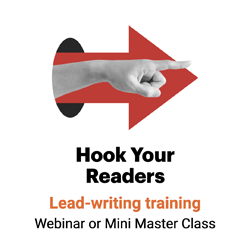4 types of web leads to try — and 3 to avoid
Lede or lead?

You won’t find it in the Oxford English Dictionary. But the alternative spelling lede was supposedly created during the linotype era so as not to confuse lead with the strip of metal that was used to separate lines of type.
The word lede still looks weird to me. But even if you prefer the spelling lede, remember: Leads lead the reader into the body of your piece.
So what types of web content leads should you try?
4 types of web leads to try
Web content’s not a newspaper story. So instead of news leads, try these four types of web leads:
1. Snappy synthesis
Don’t bury the lead under all of the W’s and H’s. Instead, steal a trick from The New York Times, and try snappy synthesis. Synthesize your subject matter into a short, snappy sentence like this:
2. Stakeholder benefits
Don’t write about us and our stuff. Instead, draw readers in by focusing on how they can use, or benefit from, our products, services, programs and ideas. Here’s how that looks:
The reason: a new, $24 million bridge that Community Transport Corp. will build this summer.
3. Data point
Can you illustrate the gist of the story with a startling statistic? If so, try a lead like this, from Visa’s Reading Is Fundamental program, for your web content:
4. Illustration
Show, don’t tell. Illustrate your essential point with an example like this, from an H&R Block survey of kids about taxes:
3 types of web leads to avoid
Don’t treat your web content as a news story … but don’t bury the lede, either. Here are three types of leads to avoid:
1. Abstraction
To draw readers into your web content, write web leads that are concrete, creative and provocative. That means dry, boring, abstract leads like this aren’t a good choice:
2. Background
The background section — aka the blah blah — belongs in the third paragraph. So keep definitions, history lessons and other broader context like this out of the opening paragraph:
3. Welcome text
According to the Nielsen Norman Group, nonessential introductions like this one cause readers to skip your lead:
Ledes should lead
Whichever lead approach you choose for your web content, make sure it’s concrete, creative and provocative. Make sure your lede leads readers into the story — instead of leading them astray.
Regardless of how you choose to spell it.
Learn more
- Learn more about lede (or lead) writing.
- Find out how to organize your message.
- Perfect the paragraph that comes after the lead: the nut graph.

Leave a Reply